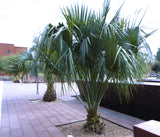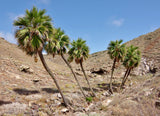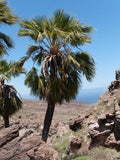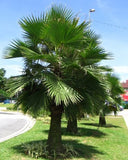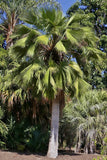Brahea edulis Seeds — “Guadalupe’s Blue Sentinel”
Plant the essence of a fog-wreathed island and tangible conservation hope in your garden. Brahea edulis, the rare blue-tinged Guadalupe Palm, is a botanical emblem of resilience—once nearly erased by feral goats, now poised for rebirth through cultivation. With these seeds, you’re not just growing a palm; you’re rekindling a legacy.
1. A Fragile Heritage Reborn
Endemic to Guadalupe Island off Mexico, this palm once stood as one of the few trees surviving the onslaught of grazing goats. Today, thanks to restoration efforts and seed propagation, cultivating it is an act of conservation—and cultural restoration.
2. Appearance & Blooming Wonder
This stately palm grows a stout, majestic trunk ringed with the patterns of fallen leaves, crowned by blue‑green fan-shaped fronds that glow with island mystique. In spring and early summer, it unveils fragrant, creamy-yellow to pale white blooms on long, drooping inflorescences held aloft amid the fronds—a perfumed beacon for wildlife.
3. Hardiness & Climate Resilience
Surprisingly hardy for its tropical lineage, Brahea edulis thrives in USDA Zones 9a through 11, tolerating occasional temperatures down to around 20 °F (–7 °C). Some accounts even suggest it survives brief dips to 10–14 °F (–10 °C) under dry conditions. Once established, it endures wind, salt spray, drought, and desert sun, making it a stalwart in water-wise, coastal, and Mediterranean-style landscapes.
4. Wildlife Magic
The fragrant flowers draw bees and other small insects, becoming an important seasonal nectar source in otherwise sparse environments. Later, the round fruits—green turning to golden brown, then black—are sweet and edible, prized by local birds as a juicy treat.
While not known as a butterfly or moth larval host, this palm offers essential sustenance and refuge within bird and insect food webs.
5. Glimmering Facts & Botanical Poetry
-
“Edulis,” meaning edible, refers to its sweet-fleshed fruit that tastes vaguely like dates or caramel—nature’s own dessert, encased in glossy drupes.
-
Slow, sure grandeur: After sprouting from seed (which germinates over 2–6 months), the palm soars up to 30–45 feet tall over decades, crafting a sculptural silhouette worthy of gardens or container statement.
-
From island rarity to global specimen: Introduced to California in the late 19th century, it's now a celebrated ornamental in Mediterranean and subtropical gardens worldwide—a rare guardian of botanical history.
Product Summary – “Guadalupe’s Blue Sentinel” Seeds
| Feature | Captivating Detail |
|---|---|
| Cultural Significance | Endangered palm from Guadalupe Island, emblem of restoration and heritage |
| Bloom Color & Fragrance | Creamy-yellow to pale white blossoms, subtly scented |
| Hardiness Zones | USDA Zones 9a–11, with cold tolerance down to ~20 °F (–7 °C) |
| Wildlife Value | Attracts insects and birds with fragrant blooms and sweet fruits |
| Growth Habit | Slow-growing, reaching 30–45 ft tall, marked with textured trunk scars |
| Edible Fruit | Sweet, date-like drupes valued by wildlife—and curious gardeners |
| Landscape Versatility | Wind-, drought-, salt-tolerant—ideal for xeriscape, coastal, and subtropical gardens |
Cultivation Notes for Intentional Planting
-
Germination patience pays off: Sow seeds in well-draining mix and expect emergence in 2–6 months. Meanwhile, nurture the vision of evolving blue fronds.
-
Sun‑loving and resilient: Plant in full sun, in well-draining soil—even chalky or poor soil is fine. Minimal irrigation is needed once roots take hold.
-
A living monument: Let the canopy soar—this palm thrives as a specimen, a xeriscaping focal point, or a heritage beacon for garden generations.
Sow these seeds and nurture a living sculpture, a fragrant ecosystem magnet, and a botanical testimony to resilience and restoration. Your garden will gain not just a palm, but a story of wild beauty reclaimed.
If you'd like pairing ideas, container strategies, or wildlife-attracting companion suggestions, let’s craft that oasis next.






